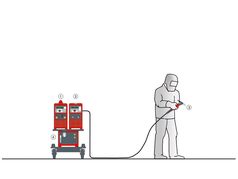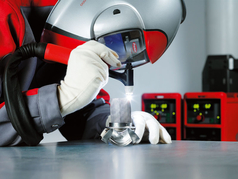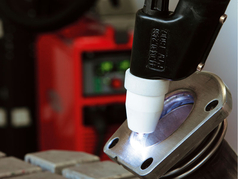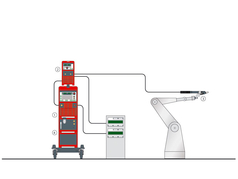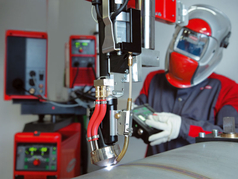Plasma welding

Plasma welding
The plasma process is basically very similar to the TIG process but has a number of critical advantages. These make it an interesting alternative to laser welding where tough quality demands have to be met, especially on sheets and other components with a sheet thickness of up to 8 mm (0.31 in.).
In plasma welding, the arc is constricted by a cooled gas nozzle. The powerfully bunched arc that results does away with the need for time-consuming weld preparation work such as V- or U-type joint preparation. This saves as much as 30 % of the fi ller metal. In turn, the higher welding speed – around 20 % faster in soft-plasma welding, for example – saves time and costs at the same time as ensuring deeper penetration. Also, being enveloped in plasma gas, the tungsten electrode has a much longer service life.
Microplasma
Base metals
chrome-nickel materials, coated and uncoated steels, titanium and all nickel-based materials
Fields of use
automotive vendor industry, for pipeline and tank construction, in mechanical engineering and structural steelwork, for rail vehicles and rolling stock, and in shipbuilding
Soft-plasma / plasma brazing
Digital TIG welding systems of the mid-range 220 to 300 A power class can be combined with the PlasmaModule 10 and the Robacta PTW 1500 plasma welding torch whenever needed. The great thing about the soft-plasma weld process is its up to 20 % higher welding speeds, meaning you save time and money. Especially on applications with sheet thicknesses of up to 3 mm (0.12") in a power range between 3 and 300 A. Either manual or mechanized utilization is possible.
Base metals
chrome-nickel materials, coated and uncoated steels, titanium and all nickel-based materials.
Fields of use
automotive vendor industry, for pipeline and tank construction, in mechanical engineering and structural steelwork, for rail vehicles and rolling stock, and in shipbuilding
Plasma-keyhole
When tough quality requirements have to be met on sheets and other components of up to 8 mm (0.31") in thickness: this is when the plasma keyhole process comes into its own. A cooled gas nozzle constricts the arc, delivering a powerfully bunched arc that eliminates the need for labor-intensive weld preparation work such as V- or U-type joint preparation. This saves as much as 30 % of the filler metal. Digital TIG power sources in the 400 to 500 A power range can simply be combined with the PlasmaModule 10 and the plasma welding torch Robacta PTW 3500 to create a plasma keyhole welding system for mechanized applications in the power range between 3 and 500 A.
Base metals
chrome-nickel materials, coated and uncoated steels, titanium and all nickel-based materials
Fields of use
automotive vendor industry, for pipeline and tank construction, in mechanical engineering and structural steelwork, for rail vehicles and rolling stock, and in shipbuilding
Are you interested in this product? Contact us using form below or contact us directly
on e-mail info@mrs.cz or call +420 545 175
844 or +420 602 707 001.
